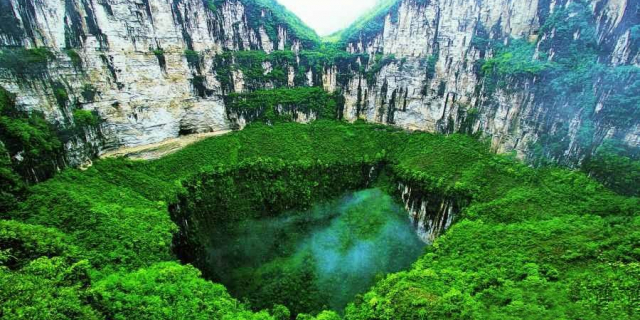泰山
( Mount Tai )Mount Tai (Chinese: 泰山; pinyin: Tài Shān) is a mountain of historical and cultural significance located north of the city of Tai'an. It is the highest point in Shandong province, China. The tallest peak is the Jade Emperor Peak (simplified Chinese: 玉皇顶; traditional Chinese: 玉皇頂; pinyin: Yùhuáng Dǐng), which is commonly reported as being 1,545 meters (5,069 ft) tall.
Mount Tai is known as the eastern mountain of the Sacred Mountains of China. It is associated with sunrise, birth, and renewal, and is often regarded the foremost of the five. Mount Tai has been a place of worship for at least 3,000 years and served as one of the most important ceremonial centers of China during large portions of this period. Because of its sacred importanc...Read more
Mount Tai (Chinese: 泰山; pinyin: Tài Shān) is a mountain of historical and cultural significance located north of the city of Tai'an. It is the highest point in Shandong province, China. The tallest peak is the Jade Emperor Peak (simplified Chinese: 玉皇顶; traditional Chinese: 玉皇頂; pinyin: Yùhuáng Dǐng), which is commonly reported as being 1,545 meters (5,069 ft) tall.
Mount Tai is known as the eastern mountain of the Sacred Mountains of China. It is associated with sunrise, birth, and renewal, and is often regarded the foremost of the five. Mount Tai has been a place of worship for at least 3,000 years and served as one of the most important ceremonial centers of China during large portions of this period. Because of its sacred importance and dramatic landscape, it was made a UNESCO World Heritage Site in 1987. It meets 7 of the 10 evaluation standards of World Heritage, and is listed as a World Heritage site that meets the most standards, along with the Tasmanian Wilderness World Heritage Area in Australia.
An earthquake or thunderstorm occurred in Mount Tai in 1831 BC or 1652 BC, also known as Mount Tai earthquake. This event was first recorded in the Bamboo Annals, and at present, it is recognized by most scholars as the first recorded earthquake in Chinese history.
Traces of human presence at Mount Tai date back to the Paleolithic period. Evidence of human settlement of the area can be proven from the neolithic period onwards. During this time, two cultures had emerged near the mountain, the Dawenkou culture to the south and the Longshan culture to the north.
During the Xia Dynasty (c. 2070–1600 BC) the mountain was known as Mount Dai (Chinese: 岱山; pinyin: Dài Shān) and lay within the borders of Qingzhou, one of the Nine Provinces of ancient China.[1]
Religious worship of Mount Tai has a tradition dating back 3,000 years, from the time of the Shang (c. 1600–1046 BC) to the Qing Dynasty (1644–1912). Over time, this worship evolved into the Feng and Shan sacrifices. The sacrifices were an official imperial rite and Mount Tai became one of the principal places where the emperor would carry out the sacrifices to pay homage to heaven (on the summit) and earth (at the foot of the mountain) in the Feng (Chinese: 封; pinyin: Fēng) and Shan (Chinese: 禪; pinyin: Shàn) sacrifices respectively. The two sacrifices are often referred to together as the Fengshan sacrifices (Chinese: 封禪; pinyin: Fēngshàn). Carving of an inscription as part of the sacrifices marked the attainment of the "great peace".[2]
By the time of the Zhou Dynasty (c. 1046–256 BC) sacrifices at Mount Tai had become highly ritualized ceremonies in which a local feudal lord would travel there to make sacrifices of food and jade ritual items. These would then be arranged in a ritually correct pattern before being buried on the mountain. In the Spring and Autumn period (771–476 BC) the vassal states of Qi and Lu bordered Mount Tai to the north and south respectively, from where their feudal lords both made independent sacrifices on Mount Tai. According to Zhou ritual belief, the spirit of Mount Tai would only accept sacrifices offered by a feudal lord, leading Confucius (in his Analects 3.6) to criticize the ministers who offered state sacrifices here after usurping power.[3] In the ensuing Warring States period (475–221 BC), to protect itself against invasion, the State of Qi erected a 500-kilometer (310 mi)-long wall, the ruins of which are still present today. The name Tai'an of the neighboring city is attributed to the saying "If Mount Tai is stable, so is the entire country" (both characters of Tai'an, "泰" and "安", have the independent meaning of "peace").
In 219 BC, Qin Shi Huang, the first Emperor of China, held a ceremony on the summit and proclaimed the unity of his empire in a well-known inscription. During the Han Dynasty (206 BC–220 AD), the Feng and Shan sacrifices were considered the highest of all sacrifices.[2]
Rituals and sacrifices were conducted by the Sui.[4]
The emperors of the past dynasties went to Mount Tai to worship the heavens and tell the earth. Confucian Buddhism, preaching, and experience, and cultural figures climbed the mountain, leaving behind a dazzling array of stone inscriptions, cliffs, and couplet stone carvings. The cliff carvings on Mount Tai are also the most famous mountains. There are more than 1,800 stone inscriptions in Mount Tai, including more than 800 steles and 1,000 cliff stone inscriptions, distributed in 157 Daimiao, 215 at Dailu, 576 at Shantou East Road, 258 at Daiding, more than 80 at Daixi, and Daiyin 44 locations, more than 400 locations in Lingyan Temple, more than 100 locations in Shentong Temple. It mainly includes 5 types of sacrificial ceremonies of the emperors of the past dynasties, the creation and restoration of temples, the tomb inscriptions of the stone scriptures, the poems of chants, the scenery and the couplets, most of which are natural stone inscriptions.[5]
Japan, India, the Persian court in exile, Goguryeo, Baekje, Silla, the Turks, Khotan, the Khmer, and the Umayyad Caliphate all had representatives attending the Feng and Shan sacrifices held by Emperor Gaozong of Tang in 666 at Mount Tai.[6]
Also, Chinese worshippers of the mountain who were not nobles have also played an important role in the history of communities near the mountain and pilgrimage across China.[7]
In 2003, Mount Tai attracted around six million visitors. A renovation project was completed in late October 2005, which aimed at restoring cultural relics and renovating damaged buildings of cultural significance. Widely known for its special ceremonies and sacrifices, Mount Tai has seen visits by many poets and literary scholars who have traveled there to gain inspiration. There are grandiose temples, many stone inscriptions and stone tablets with the mountain playing an important role in the development of both Buddhism and Taoism.[8]


































Add new comment